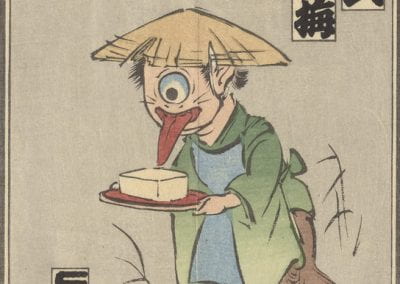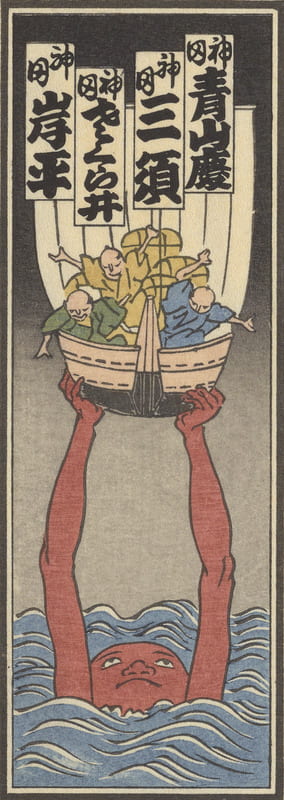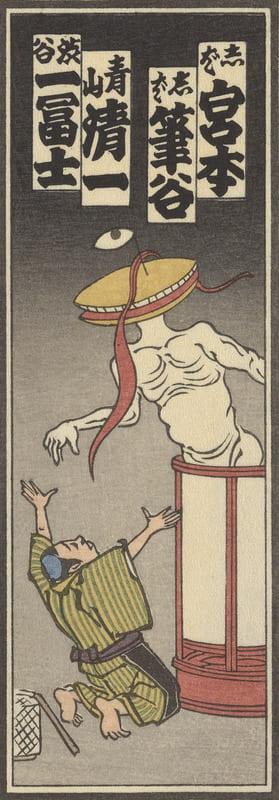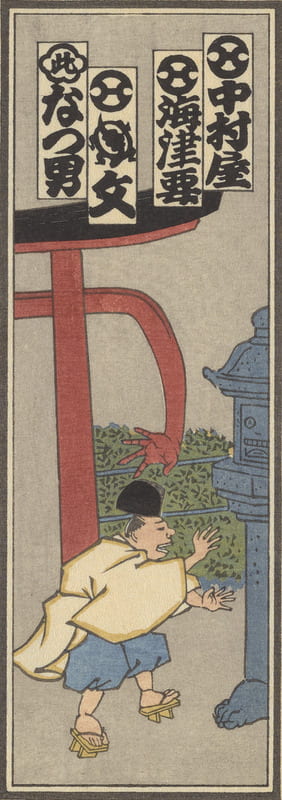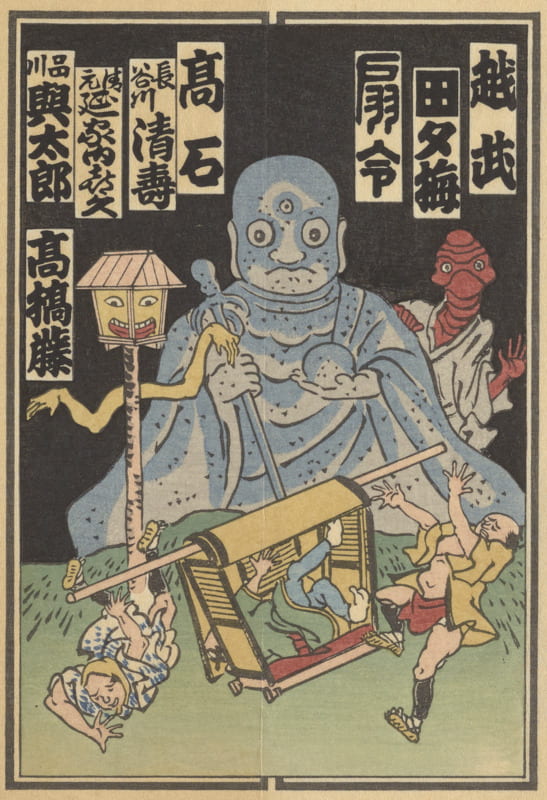A senjafuda yōkai series
Some of the renfuda sets in the UO collection come with labels, announcements, or other kinds of documentation setting out the theme of the set, the name of the group producing it, the date and perhaps even location of the exchange meeting for which it was being produced, and sometimes even the reason why this particular theme was chosen. Furthermore, the internal logic of the slips or evidence of careful arrangement in the scrapbooks sometimes suggests that the slips were intended to be viewed in a particular order. The “hell scroll” set discussed elsewhere is an example of a set of renfuda that contains all the information a scholar would like to see.
The set of senjafuda discussed on this page comes with none of that information. We don’t know when the set was made or why, how the group formulated its theme to themselves, what order we’re meant to view the slips in (if any), or even if this is all the slips originally made as part of the set. This is too bad, because it’s one of the most charming sets in the collection—and particularly intriguing from the point of view of yōkai. It’s obviously a collection of yōkai, presented (generally) one to a slip in the manner of the sugoroku gameboard and matchbox labels discussed elsewhere. Like them, then, it can be seen as part of the tendency to organize and (to an extent) rationalize presentations of yōkai (even if we don’t know what the original organizational scheme might have been).
A closer look, however, reveals that the yōkai presented here are much less orthodox than they appear at first glance. Not all of them can be identified with “known” yōkai, and even the ones that can be named are often presented with playful disregard for precedent. The neatness with which these monsters are framed for us disguises an anarchic, creative spirit that owes a great deal to the “pandemonium” of the hyakki yagyō.
Many, but not all, of the images here seem closely patterned on an untitled large format single-sheet print held in the Yumoto Koichi Collection.[1] The print has more images than are found in the UO’s senjafuda series, while the UO series has one image (the first one discussed below) not found in the Yumoto print. The Yumoto Koichi Collection also contains a set of matchbox labels (many bearing the name Minami Kichijirō, like those in the Starr Collection) featuring many of the same designs as in this senjafuda series.[2] The exact relationship between the single-sheet print, the senjafuda, and the matchbox labels is unclear.
First slip: At first glance this is Tofu Boy, in a rendition very close to that on the sugoroku board. Oversize single eye, lolling tongue, tattered sedge hat, and a tray of tofu all support that identification—but then we notice the furry legs and tail. What we have here is a tanuki that has half shape-shifted into Tofu Boy—a yōkai pretending to be another yōkai. Is this a tanuki, like the one in “The Lucky Teapot” (discussed on the sugoroku page), losing his concentration? Incidentally, the Japanese expression roughly equivalent to the English “to tip one’s hand” is “to show one’s tail” (shippo o dasu 尻尾を出す), a reference to stories of foxes and tanuki inadvertently revealing their deception by letting their tails pop out.
Second slip: A huge paper lantern turning into a leering face should immediately put us in mind of Oiwa from Yotsuya kaidan (discussed on the sugoroku page and the matchbox labels page). No doubt most members of the ren would have made that connection too, but note that it’s not Oiwa’s villainous husband Iemon who’s being frightened here but a hapless priest. This combined with the lack of flames and the kind of ghostly or feminine elements usually found in representations of the Oiwa lantern scene suggest that this could also be a more generic monster lantern or obake chōchin sometimes found in yōkai collections. Toriyama Sekien’s fourth bestiary, Hyakki tsurezure bukuro (A hundred things in a bag of idleness, 1784), contains an early depiction of one under the name burabura (“dangly-dangly”).
Third slip: A female ghost holding a broken dish, rising from a wooden well along with flames. This is one of the few more-or-less orthodox depictions in this series: all the above attributes clearly mark this ghost as Okiku from the Sarayashiki (“Dish Manor”) legend. Like Oiwa and Kasane, Okiku has been the subject of endless stageplays, films, and other presentations; in its most basic outlines her story is that of a housemaid in a wealthy house who breaks an heirloom dish. The master of the house, enraged, kills her and throws her into a well, from which her ghost later emerges. The man being haunted here appears to be an innocent passerby; the two sticks on the ground next to him are probably clappers, suggesting that the man is a neighborhood watchman making his rounds. In Edo watchmen would call out fire safety reminders at night to the sound of clappers.
Fourth slip: A ghost with a sickle sticking out of her neck. Early 20th century viewers would have associated this imagery with the story of Kasane, as discussed on the matchbox labels page. This version of Kasane’s ghost towers over the men on the bridge in the foreground, however, which is a notable departure from most ghost stories. Here, too, the men seem to be unrelated to the ghost’s story, further underscoring how even the identifiable yōkai in this series are unmoored from their typical contexts, set free to haunt anybody and everybody.
First slip: The matchbox label may or may not have been an ōkubi, but this certainly is: a huge ghostly head appearing on a dark night. The mallet on the ground belongs to the small gong this victim is wearing around his neck, a common accoutrement of pilgrims (and of Ōtsue demons).
Second slip: The motif on this slip is similar to the one on the previous slip: a huge female face appearing to startle a man out of his wits. This face looks more demonic than ghostly, with coloring and features similar to a noh hannya mask, but where horns should be there are two more small faces. This may simply be a flight of fancy on the artist’s part—although, interestingly, the International Research Center for Japanese Studies’ database of yōkai legends (Japanese only) contains one entry for a sanmenkubi or “three-faced head,” which is described as a noh mask with angry, laughing, and crying faces. In addition, a 1788 kibyōshi (kind of an early modern comic book) called Bakemono chakutōchō (Monsters Reporting for Duty), shows a mitsumen uba or “three-faced wetnurse.”[3] There it’s a jokey pair with a one-eyed boy, which is usually how it’s depicted today. This doesn’t look like that, but the idea could have inspired this image.
Third slip: At first glance the long curly neck with a bulbous head at the end may fool the viewer into thinking this is a rokurokubi. But the hands near the head rule that out, and the head itself is anomalous, to say the least: not so much a hitotsume or one-eye as a head that’s all eye. To a modern viewer this creature is strangely reminiscent of yōkai manga artist Mizuki Shigeru’s character medama oyaji, or “Eyeball Dad,” but Mizuki didn’t invent him until the 1950s. No older yōkai has been identified that corresponds to this creature, but note that it’s emerging from a sake bottle. It might be intended as nothing more than the manifestation of a wicked hangover-in-the-making.
Fourth slip: An abnormally large red horse glares down at a fearful passerby. Although several known yōkai are associated with horses, none seem at all similar to this image. It may be intended to suggest the famed Red Hare Horse mentioned in Chinese historical tales: eight feet tall with a pure red coat. But again, the main point might be the sheer whimsical strangeness of the image—which extends to the rider, whose face is mysteriously hidden by his hat and whose limbs are contorted in what could be glee, drunkenness, or fear.
First and second slips: These both seem to depict umibōzu or sea-monks, popular yōkai that we’ve already encountered in both the sugoroku board and the matchbox labels. On both slips the yōkai fits the traditional depiction, being large and seemingly composed mostly of shadow. Indeed, we can see right through the eyeholes and mouths of these creatures to the “sky” in the background, a playful artistic touch that suggests three-dimensional human victims confronting no-dimensional antagonists.
Third slip: Despite the red skin and other indications of corporeality that contrast with the previous two slips, this too might be intended to suggest an umibōzu. Although most depictions of this yōkai show it as in the previous two slips, Bakemono chakutōchō imagines the umibōzu as a huge, scaly, finny, toothy creature, and shows it mauling and gnawing at a boat. That image doesn’t quite fit this one either, but it suggests the concept is fairly elastic. In any case, the way the monster has lifted the boat straight out of the water while keeping it perfectly level, rather than capsizing it, is both striking and a little funny.
Fourth slip: Here, too, the impact of the image is probably more important than any particular identification: a huge red arm coming out of the clouds to lift a man up by the ankle. But the red color suggests oni, and the combination of clouds and oni suggest a thunder god (discussed elsewhere). When thunder gods attack it’s usually with lightning rather than by hand, but that incongruity just adds to the surprise and humor of the image. It could also be a reference to the old concept of kamikakushi 神隠し, literally “hidden away by a god.” Traditionally this was a phenomenon associated with tengu, who were said to disappear children on occasion (of course the term also shows up in the original Japanese title of the Ghibli film known in English as Spirited Away). But the literal meaning of the term conjures up the image of a god snatching someone away, and the 1853 Kyōka hyaku monogatari (A hundred stories in comic verse), a compendium of yōkai illustrations combined with comic verse on corresponding themes, depicts a kamikakushi being perpetrated by an actual god. That god looks nothing like this one, but the artist may be imagining a thunder god “hiding” his victim away.[4]
These three slips depict three kinds of lamp monsters. All three are types of andon 行灯 or oil lamps primarily for indoor use. The first one shows a very human-looking foot sticking out of one of the paper panels, as well as a smiling face. The second shows two arms and one leg, as well as a face where a drawer for wicks or flint and steel would have been. The third is harder to parse: an entire body has sprung up from inside a cylindrical lamp; the head appears to be an oversized container for oil, with the wick-stand holding an eye. As animated objects these would probably have been considered tsukumogami, but to an Edo eye these lamps would have appeared modern, a notable contrast to the tsukumogami associated with hyakki yagyō illustrations. Of course, this set of senjafuda was made in the early 20th century, complicating our ideas of what would have been perceived as “modern” and or “old-fashioned.”
First and second slips: Architecture comes alive! In the first slip, the torii gate in front of a Shintō shrine attacks a priest—the end of its lower crosspiece has sprouted a grasping hand. The priest may or may not be aware of impending danger from above, however: he appears to be reacting instead to the stone lantern in front of him, whose pedestal has become an actual foot (look closely at the top—there might be a face there, too). In the second slip, a tea-ceremony hut has become the head of a giant red-robed monster.
Third slip: This and the tanuki Tofu Boy are the only two-chō slips in this series, suggesting they might have been meant to begin and end the group (although that’s only a guess). In any case, this is a fitting finish, as it’s the only slip to show more than one yōkai, suggesting yōkai energy bursting through any lingering sense of order or restraint. Here a pair of palanquin bearers are startled into dropping their cargo and spilling its occupant when they’re confronted by three looming monsters. On the left there’s yet another animated lantern. In the center we have a gargantuan statue of the bodhisattva Jizō—his round white eyes suggest he has come to life. And on the right we might have a mikoshi nyūdō (previously seen on the sugoroku board and just possibly in the matchbox label series). Its red, wrinkly flesh is nothing like the typical Overlooker’s, but its position, peering over Jizō’s shoulder, is appropriate. On the other hand, this may be an akanyūdō or “red initiate,” a bald, red-skinned (but not wrinkly) yōkai mentioned in a Meiji-era scroll in the Yumoto Koichi collection.[1]
References
[1] Yumoto Koichi, Yokai Museum: The Art of Japanese Supernatural Beings from YUMOTO Koichi Collection (PIE International, 2013).
[2] Yumoto Koichi, Yokai Wonderland: YUMOTO Koichi Collection (PIE International, 2017).
[3] Bakemono chakutōchō, illustrated by Kitao Masayoshi, is reprinted, transcribed, and annotated in Adam Kabat アダム・カバット, Edo bakemono sōshi 江戸化物草紙 (Shōgakukan, 1999).
[4] Kyōka hyaku monogatari, illustrated by Ryūsai Masazumi, is reprinted, transcribed, and annotated in Kyōgoku Natsuhiko 京極夏彦 and Tada Katsumi 多田克己, Yōkai gahon: Kyōka hyaku monogatari 妖怪画本・狂歌百物語 (Kokusho Kankōkai, 2008).
